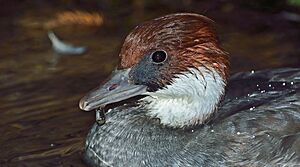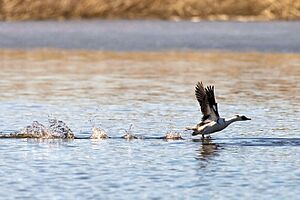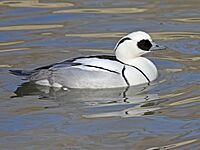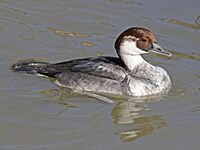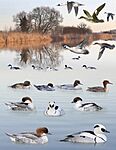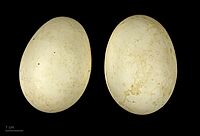Smew facts for kids
Quick facts for kids Smew |
|
|---|---|
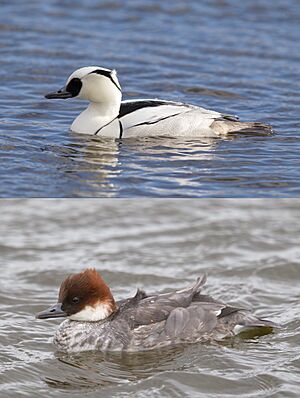 |
|
| Male (top) and female smew | |
| Conservation status | |
| Scientific classification | |
| Genus: |
Mergellus
|
| Species: |
albellus
|
 |
|
| Range of M. albellus Breeding Non-breeding Passage | |
| Synonyms | |
|
|
The smew (Mergellus albellus) is a small type of duck. It is the only living member of its group, called Mergellus. The name Mergellus means "little Mergus", and albellus comes from a Latin word meaning "white". Smews are related to other ducks like the goldeneyes. Sometimes, smews even breed with common goldeneye ducks.
Contents
What is a Smew?
The word smew has been used for this bird since the 1600s. Its exact origin is not fully known. It might be linked to similar words in Dutch and German that mean "wild duck."
Appearance and Features
Male smews are easy to spot. They have a striking black and white pattern, sometimes called a 'cracked ice' or 'panda' look. When they fly, they look very distinct.
Female smews and young males look different. They are mostly grey with a reddish-brown forehead and top of the head. From a distance, they might be confused with other ducks. People sometimes call them "redhead" smews.
When smews fly, you can see oval-shaped white patches on their wings. Their bill (beak) has a hooked tip and jagged edges. These features help them catch fish when they dive underwater.
Smews are about 38 to 44 centimeters (15 to 17 inches) long. Their wings can spread out 56 to 69 centimeters (22 to 27 inches) wide. They usually weigh between 450 and 650 grams (about 1 to 1.4 pounds).
Where Smews Live and Their Habits
Smews breed in the northern forests of Europe and Palearctic. They need trees to make their nests. These ducks prefer lakes and slow-moving rivers that have plenty of fish.
Smews are migratory birds. This means they travel to different places depending on the season. After breeding, they fly to warmer areas for winter. They spend winter on sheltered coasts or inland lakes. You can find them around the Baltic Sea, the Black Sea, and in northern Germany. A small number also reach Great Britain.
When on lakes, smews often stay near the edges, sometimes hiding under small trees. They are shy birds and will fly away easily if disturbed.
Reproduction and Life Cycle
Smews usually breed in May. The female lays 7 to 11 cream-colored eggs. She sits on the eggs for 26 to 28 days to keep them warm. This process is called incubation.
Once the ducklings hatch, they leave the nest very soon after. They learn to fly when they are about 10 weeks old. Smews often nest in holes in trees. They especially like old nests made by woodpeckers.
Conservation Status
The smew is part of an agreement to protect migratory waterbirds in Africa and Eurasia (AEWA). The IUCN Red List does not consider the smew to be an endangered species. However, the number of smews in the world is slowly decreasing.
Images for kids



